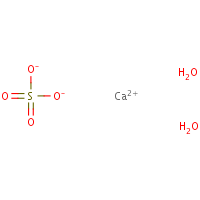Calcium sulfate dihydrate
Agent Name
Calcium sulfate dihydrate
CAS Number
10101-41-4
Formula
O4-S.Ca.2H2-O
Major Category
Metals

Synonyms
Annaline; C.I. 77231; Compactrol; Light spar; Magnesia White; Mineral White; Native calcium sulfate; Precipitated calcium sulfate; Satin spar; Satinite; Sulfuric acid, calcium(2+) salt, dihydrate; Terra alba; Calcium(II) sulfate, dihydrate (1:1:2); Sulfuric acid, calcium salt (1:1), dihydrate; Calcium sulfate, dihydrate; [ChemIDplus] Gypsum; Alabaster; Selenite; [Merck Index] C.I. Pigment White 25; Gypsum stone; Land and plaster; [OECD SIDS: Calcium sulfate, dihydrate - 2003]
Category
Metals, Inorganic Compounds
Description
White to slightly yellowish-white odorless solid; [Merck Index] Colorless hygroscopic solid; [OECD SIDS: Calcium sulfate, dihydrate - 2003] White powder; [Sigma-Aldrich MSDS]
Sources/Uses
Used to make Portland cement, plaster of Paris, artificial marble, and porous polymers; Also used in soil treatment, paints/enamels (pigment), pharmaceuticals, paper, insecticide dusts, water treatment, polishing powders, and plaster casts; [Merck Index] Used in Portland cement retarders, tiles, plaster, wallboard, polishing powders, paints, paper, dyeing and calico printing, metallurgy (reduction of zinc minerals), food additives, desiccants, as source of sulfur and sulfuric acid, for drying industrial gases, solids, and organic liquids, as soil conditioner, in adhesives and binding agents, and to make other non-metallic mineral products; [OECD SIDS: Calcium sulfate, dihydrate - 2003] Permitted for use as an inert ingredient in non-food pesticide products; [EPA]
Comments
Not a skin irritant in rabbits; No evidence of skin sensitization in guinea pigs; Decreased total protein, albumin, BUN, AST, ALT, and creatinine observed in males at 300 and 1,000 mg/kg/day in repeated-dose oral study of rats (possible effect on excretion, distribution, or metabolism relating to the kidney); No adverse effects observed in females at dose up to 1,000 mg/kg/day; No evidence of reproductive or developmental toxicity in rats at oral doses up to 1,000 mg/kg/day; No evidence of mutagenicity; [OECD SIDS: Calcium sulfate, dihydrate - 2003] May cause mechanical irritation; Repeated or prolonged exposure to dust particles may cause lung effects; [ICSC] May cause irritation; [Sigma-Aldrich MSDS] See "Calcium sulfate." See "Gypsum."
Biomedical References
Exposure Assessment
Skin Designation (ACGIH)
Insufficient data
TLV (ACGIH)
10 mg/m3, inhalable fraction
PEL (OSHA)
15 mg/m3(total dust), 5 mg/m3(respirable fraction)
MAK
4 mg/m3(inhalable fraction), 1.5 mg/m3(respirable fraction)
Diseases, Processes, and Activities Linked to This Agent
Processes
Industrial Processes with risk of exposure: